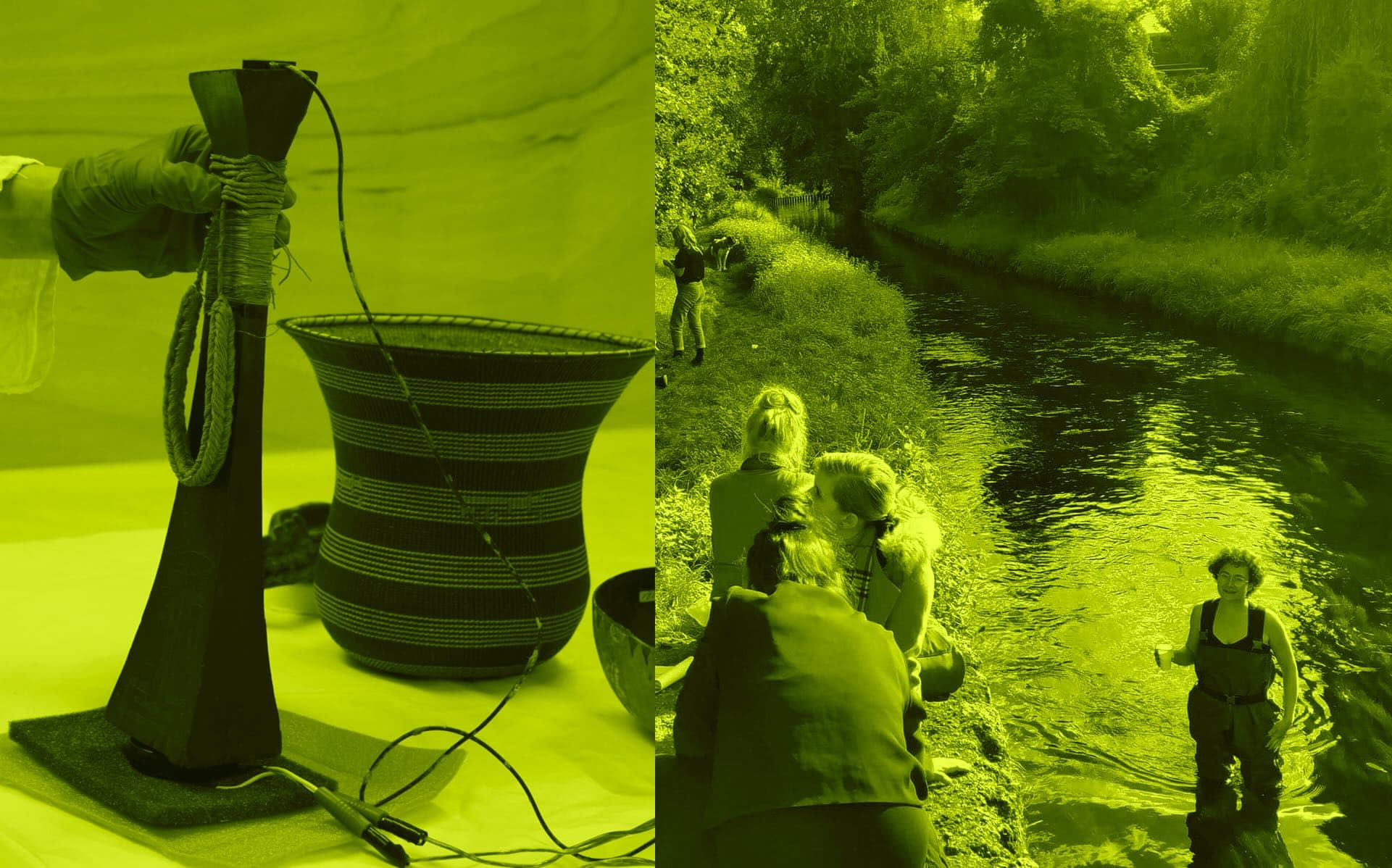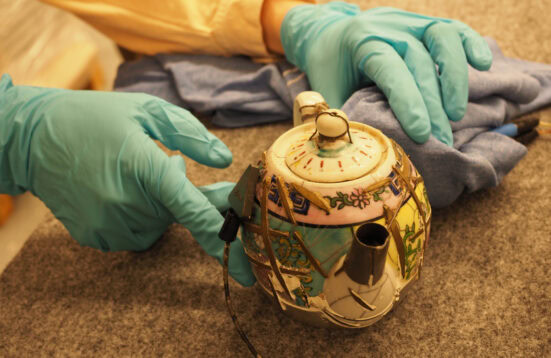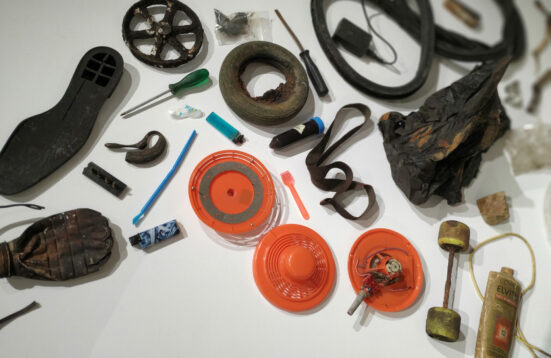ZOOM IN!
Current Collaborations Between Art, Biology, Music, and Anthropology
Panel Discussion | With Isabel Bredenbröker, Adam Pultz, India Mansour, Sybille Neumeyer, Regine Rapp, and Christian de Lutz

Left image: Isabel Bredenbröker and Adam Pultz | right image: ALB
Join us at BERLIN SCIENCE WEEK at Holzmarkt 25 (Berlin Mitte)!
How do bodies sound? How can we visualize strategies for accessing environmental data from closed systems called biospheres? And how can a group of cultural belongings in an ethnological museum collection resonate in unexpected queer kin relations? Art Laboratory Berlin welcomes you to a diverse panel with cutting edge transdisciplinary research projects on current research topics: From postcolonialism over to postanthropocentrism, they nurture their knowledge production by transgressing discipline borders with a radical openness for nonhuman subjectivities.
A conversation with:
Isabel Bredenbröker PhD (Anthropologist| HU Berlin)
Adam Pultz PhD (Artist, musician | Berlin)
India Mansour PhD (Biologist, ecologist | FU Berlin)
Sybille Neumeyer (Artist, researcher | Berlin)
Regine Rapp (Art Historian and curator, Art Laboratory Berlin)
Christian de Lutz (Curator and researcher, Art Laboratory Berlin)
In their interactive multichannel sound installation Queer Sonic Fingerprint, sound artist Adam Pultz and anthropologist Isabel Bredenbröker speculatively imagine non-normative relations around cultural belongings in ethnological museums and beyond. The installation, that will be on view at Art Laboratory Berlin between 19 October and 1 December 2024, amplifies the collections’ materiality through sonic fingerprints – that is – the reflections of a body’s unique acoustic characteristics. In a transdisciplinary encounter with sound processing and evolutionary computing, dynamically changing fingerprints bring selected parts of museum collections to life in a multichannel sonic ecology. Queerness contains a tension, something which gender and sexuality studies scholar Susan Talburt identifies as a fundamentally productive quality. Cultural belongings in ethnographic collections are things deeply affected by the colonial encounter and its political aftermath. They, too, are caught in a tense state, as current debates about ownership, their history, their representative functions, and proper place come to show. Voices from indigenous communities and scholars have reframed so-called ethnographic “objects” in museum collections as person-like entities.
In an ongoing art-science experiment, microbial ecologist and biologist India Mansour is developing strategies for accessing environmental data from closed systems called biospheres. Her scientific research involves working with very tiny approaches to such biospheres – the μbiospheres – through which she seeks to understand the point at which ecological systems fail and what such failure can tell us about the potential of microbial agents at micro and macro levels. In conjunction with an online residency in the Rillig Lab (FU Berlin) during the pandemic and with programming at ALB, artist and researcher Sybille Neumeyer collaborated with India Mansour on these questions: They were sampling algal cultures from the Panke River and collecting data from inoculated μbio-spheres in the lab. In the context of their art-science dialogues, Dr. India Mansour and Neumeyer are developing experiments for accessing environmental data from biospheres while examining conceptions of signals, songs, closed systems, failures and persistence.
About the Speakers and Moderators
Isabel Bredenbröker is a social and cultural anthropologist working between art and academia. They hold a DFG Walter Benjamin Postdoctoral Fellowship which is based between the Centre for Anthropological Research on Museums and Heritage (CARMAH) and the Hermann von Helmholtz-Zentrum für Kulturtechnik at Humboldt University Berlin. Isabel’s work focusses on material and visual culture, anthropology of art and museums, queer theory and intersectionality, situatedness and autoethnography, colonialism, cleaning and waste. They have produced ethnographic films, worked with field recording and (co-)curated as well as contributed to exhibitions in museum and contemporary art contexts. Isabel’s book Rest in Plastic: Death, time and synthetic materials in a Ghanaian Ewe community has recently been published open access with Berghahn. More information here.
Adam Pultz Melbye is a double bass player, composer, and improviser working in the field of acoustic and electronic sound. Adam’s work spans live performance, sound installation, sound for dance, theatre, film, multimedia, sculpture, algorithmic design, and instrument building. They have performed and exhibited work in Europe, Australia, the US, and Japan, while appearing on close to 50 albums. Adam often performs with semi-autonomous feedback systems, such as the FAAB (feedback-actuated augmented bass). Adam holds a practice-led PhD in music technology from SARC, Queen’s University Belfast. More information here.
India Mansour, guest professor at the Free University Berlin (Institute of Biology, Plant Ecologies | Rillig Lab), researches how microbial communities shape and are shaped by their environment and their interactions. She completed her PhD in River Science in Germany and the UK, investigating soil and river microbial ecology. This, in part, involved conceptual development of the community coalescence concept: collisions of previously disparate microbial communities. Her current research focuses on communities within matter-closed, energy-open systems, known as microbial biospherics. India is a member of DIY Hack the Panke, an interdisciplinary artistic research group exploring the Panke River. More information here.
Sybille Neumeyer is an interdependant artist and researcher with focus on environmental issues and relationships between humans and non-humans. Her work is informed by post-disciplinary research and collaborations. Through polyphonic (hi)storytelling, installations, walks, performative lectures and video essays she is examining the intersections of biocultural diversity loss, environmental issues and climate crisis, searching for narratives towards social, ecological and multispecies justice. More information here.
Regine Rapp is an art historian, curator, and co-director of Art Laboratory Berlin, researching, teaching, curating, and publishing on 21st century art at the interface of science and technology. Since March 2024 she is also guest professor for Art and Science at the Art Academy Münster where she currently teaches Hybrid Art. Rapp has conceived, curated, and researched numerous art science research projects (Synaesthesia, [macro]biologies & [micro]biologies), and developed several international conferences, e.g. Nonhuman Agents (2016/17), Under the Viral Shadow. Networks in the Age of Technoscience and Infection (2021). Recent publications: Matter of Flux. Art, Biopolitics, and Networks with Care (2024); Hybrid Art Histories (2024).
Curator and researcher Christian de Lutz focuses on the interface of art, science and technology in the 21st century, with special attention given to BioArt, DIY Science initiatives and facilitating collaborations between artists and scientists. After co-founding Art Laboratory Berlin in 2006, he co-directs this art and science reesrach platform where he has developed over 50 exhibition projects, numerous talks, workshops, seminars, and conferences, for instance Nonhuman Subjectivities or Under the Viral Shadow. He has published numerous articles and essays in journals and books, recently Duelling Epistemologies. How Artists Hack Laboratories and Alter the Futures of Science (2024), The Anosmatic Symposium (2024).






